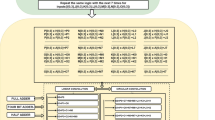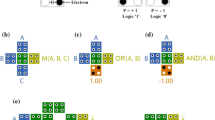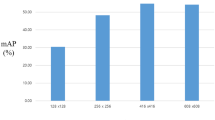Abstract
In this paper, a Nios II processor based hardware/software co-design architecture with high expandability and development flexibility is proposed. The architecture integrates a pipelined color space converter (CSC), hardware accelerator (HA), and a LCD touch module (LTM) HA, which facilitates a high-speed implementation of RGB to YCbCr color space conversion with a real-time image display. To avoid the inefficiency of CSC circuit architecture due to massive floating-point multiplication operations in the conversion formulae, a GA-based evolutionary technique is used to realize the fast multiplierless CSC hardware architecture. Meanwhile, a pipeline design method is further applied to enhance the maximum operating frequency in circuit design. As compared to the commonly used floating-point based CSC architecture, the pipelined CSC HA in this paper has excellent advantages of low-complexity and high speed. After the mechanism is integrated into a system-on-a-programmable-chip (SOPC), the maximum operating frequency reached 168.12 MHz. That is, in every 0.11 s, the color space conversion can process a 512 × 512 image. This excellent result is practical to the fast development of different kind of image/video processing systems.















Similar content being viewed by others
References
Parker, M.: High-performance Floating-point Implementation Using FPGAs. In: Proceedings of the 28th IEEE conference on Military communications, pp 323–327 (2009)
Alaoui Ismaili, Z.E.A., Moussa, A.: Self-partial and dynamic reconfiguration implementation for AES using FPGA. Int. J. Comput. Sci. Issues 2, 33–40 (2009)
Fons, F., Fons, M., Cantó, E.: Real-time embedded systems powered by FPGA dynamic partial self-reconfiguration: a case study oriented to biometric recognition applications. J. Real-Time Image Proc.—Special Issue on Real-time biometrics and Secure Media (2011)
Li, S.A., Hsu, J., Wong, C.C., Yu, C.J.: Hardware/software co-design for particle swarm optimization algorithm. Inf. Sci. 181(20), 4582–4596 (2011)
López, M., Daugman, J., Cantó, E.: Hardware-software co-design of an iris recognition algorithm. IET Inf. Secur. 5(1), 60–68 (2011)
Kamil, K., Paweł, T., Mariusz, R.: Whirlpool SOPC implementation—hardware/software co-design example. Int J. Electron C 58(1), 21–26 (2012)
Yao, X., Higuchi, T.: Promises and challenges of evolvable hardware. IEEE Trans. Syst. Man Cybern. Part C 29(1), 87–97 (1999)
Higuchi, T., Liu, Y., Yao, X.: Evolvable Hardware. Springer, Heidelberg (2006)
Haddow, Pauline C., Tyrrell, Andy M.: Challenges of evolvable hardware: past, present and the path to a promising future. Genet. Program Evolvable Mach. 12(3), 183–215 (2011)
Holland, J.H.: Adaptation in Natural and Artificial Systems: An Introductory Analysis with Applications to Biology, Control and Artificial Intelligence. University of Michigan Press, Ann Arbor (1975)
Back, T.: Evolutionary Algorithm: Comparisons of Approaches, Computing with Biological Metaphors. Chapman and Hall, Cambridge (1994)
Page, Andrew J., Naughton, Thomas J.: Framework for task scheduling in heterogeneous distributed computing using genetic algorithms. Artif. Intell. Rev. 24(3–4), 415–429 (2005)
Zhou, B., Peng, Y., Hwang, D.: Pipeline FFT architectures optimized for FPGAs. Int. J. Reconfig. Comp. 2009, 1–9 (2009), Article ID 219140. doi:10.1155/2009/219140
Greisen, P., Heinzle, S., Gross, M., Burg, A.: An FPGA-based processing pipeline for high definition stereo video. EURASIP. J. Image Video Proces. 2011(18) (2011). doi:10.1186/1687-5281-2011-18
Batlle, J., Martii, J., Ridao, P., Amat, J.: A new FPGA/DSP-based parallel architecture for real-time image processing. J. Real-Time Image Proc. 8(5), 345–356 (2002)
Bensaali, F., Amira, A.: Design and efficient FPGA implementation of an RGB to YCrCb color space converter using distributed arithmetic. Int. J. Graph. Vis. Image Process. 5(1), 37–47 (2004)
Application Note: CSC color space converter, CAST, Inc., http://www.cast-inc.com (2002)
Datasheet: High performance color space converter, ALMA Technologies, http://www.alma-tech.com (2002)
Datasheet: Color space converters, Amphion semiconductor Ltd, DS6400 V1.1, http://www.amphion.com (2002)
Acknowledgments
We would like to thank the anonymous reviewers for their valuable comments. This research was supported by the National Science Council of the Republic of China under Contract Nos. NSC 100-2221-E-130-019 and NSC 100-2622-E-032-004-CC3.
Author information
Authors and Affiliations
Corresponding author
Rights and permissions
About this article
Cite this article
Li, SA., Chen, CY. & Chen, CH. Design of a shift-and-add based hardware accelerator for color space conversion. J Real-Time Image Proc 10, 193–206 (2015). https://doi.org/10.1007/s11554-013-0324-7
Received:
Accepted:
Published:
Issue Date:
DOI: https://doi.org/10.1007/s11554-013-0324-7




